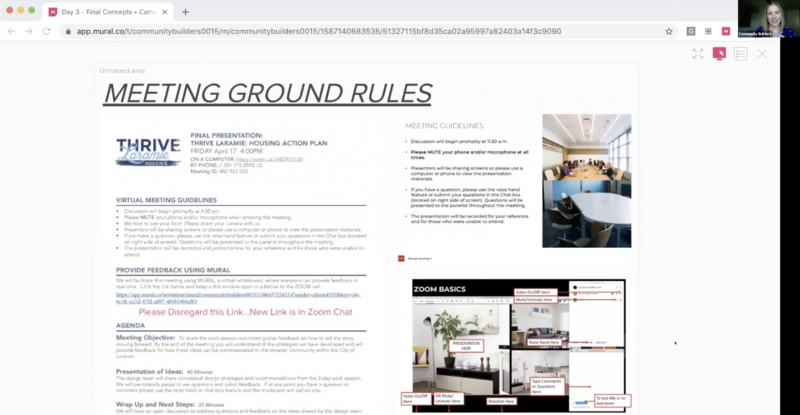Since August of 2019, Community Builders has been working on a technical assistance project in partnership with the City of Laramie to understand local housing issues and respond with strategic actions. Our workshops are usually the crescendo of our projects, a time of excitement and significant progress on ideas.
But when COVID-19 hit we were faced with a decision: put the project on hold, or modify our approach to move the project forward.
In a few short weeks we adjusted our approach and began planning a virtual work session. And, ultimately, we pulled it off!
We know many communities are facing challenges regarding virtual engagement, process, and facilitation during the COVID-19 crisis. So, we’re sharing some things we learned along the way:
#1. Plan, Plan, Plan—Then Practice
Have an agenda and make it fun! In a virtual format you can’t read the room and shift as easily, so it is easy to lose attention of your attendees. Send the agenda ahead of time, include a link on how to use the platforms you choose, and include pre-meeting exercises.
Outline meeting guidelines. When it comes time for your meeting, log in to the virtual platform of your choosing early and get situated before your participants show up. Make sure you have a neutral background and minimize distractions. Take a moment at the beginning of the meeting or workshop to explore the tools you will be using and set some meeting rules, ‘like keep your phone on mute’ or ‘type questions into the chat box’.

We made a slide that showed the zoom screen layout that highlighted the locations of the various buttons. We did a test asking everyone to practice raising their hands; a very useful tool for online facilitation. Then we asked a fun question in the chat box. My favorite was, “What is your favorite quarantine pastime?”. My response was yoga, my team’s response was ‘day drinking’. Needless to say, it broke the ice and set the tone for a fun meeting.
Use interactive and visual tools. To keep people engaged try using polls, real time comments, chats, and drawing on-screen during the meeting. You will need a moderator and technical support from your co-workers. Ask different people from your internal team to manage the chat box, take notes on screen, watch for questions, and monitor raised hands. During the meeting, present and gather information in different ways to capture your audience.
Keep time. Maintaining time is important to keeping people engaged. In the virtual environment it is easy for someone to get up and walk away from their computer if the meeting goes off track. Break frequently to pause for reflection, take a coffee or yoga break, or ask strategic questions throughout a presentation.
Follow up promptly. Record your meeting and send a link with follow up surveys for people who couldn’t attend. A great benefit of virtual platforms is the built in input tracking that makes it easier to summarize and share takeaways. To reach a wider audience and share insights consider a short project video, summary document or notes, infographics, etc. If you can, use your social media accounts!
#2. Choose Your Tools Wisely
Pick the right tool. The sheer number of tools available can be a little overwhelming. Each has different benefits and drawbacks. It is important to think about the meeting, participants, the desired outcomes and use the tool that fits the situation. Ask yourself, “what does this group need to know right now?” and determine the best tools based on the answer.
Do we use GoToMeeting or Zoom or Google Hangouts? We used all three at different times depending on the participants of each meeting. Zoom was better for the public and stakeholders, Google Hangouts was best for internal collaboration, and GoToMeeting was the best for consultant teams.
But don’t use too many tools. Instead of overwhelming participants with virtual tools, provide different ways for people to engage with just one platform. For example, stream Zoom to Facebook Live. Allow for people to call in on their phone or computer to provide options and record the meeting for people to stream it later.
We scaled back some of the additional tools we had initially planned on using. Instead of integrating polling we asked questions in the chat box or by using the raise hand tool to have a discussion.
Practice with the tools you choose. In preparation for the work sessions, take the webinars each platform offers, read blogs, practice with a coworker, practice with your team. The goal is for you as the moderator and facilitator to be ‘expert’ and lead the way.

I love facilitating with whiteboards, flipcharts, post-it note exercises and having walls covered with ideas. The collaboration tool we chose, Mural, offers the opportunity to do many of those activities virtually. Participants logged in for interactive facilitated exercises and I also used the platform to share my screen to present concepts. It allowed participants to share materials mid-meeting without handing over the controls, to track comments via post it notes in real-time, and to reflect back as a team after the session to discuss how to move the work forward.
Send Pre-work exercises. Send an easy and fun exercise before the meeting so participants have the chance to become familiar with the platform you are using. Pre-work allows participants to play with the new tool and gets them logged on ahead of time to avoid any technical hiccups that might hold up the meeting. Pre-work is a great way for people to build comfort with the platform and definitely make meetings more fun.
#3. Keep It Simple
Virtual attention spans are VERY short. It is best to keep meetings under one-hour, keep it interactive and provide breaks. Back to #1, that’s why your agenda is so important; have an agenda, reiterate the agenda, tell people exactly where you are on the agenda.
Stick to the Big Ideas. It is difficult to cover a lot of content in a virtual format. Think about your meeting attendees and structure the flow to cover specific needs. Recognize that some ideas may not be addressed the same way they would be in person or in an open house setting and that is okay- you can still build support and buy in.
#4. Build Trust
Check In. In these uncertain times, and specifically on virtual platforms, remaining present and engaged will be a crucial way to build trust. A great way to plan for this is to do emotional check-ins at the beginning of each meeting. People need space to share and connect right now when we all feel so isolated. This also creates space for acknowledging missteps or where things could be better throughout the workshop and opens the lines of communication with your participants.
Meet people where they are. Meeting attendees will likely have different levels of comfort communicating virtually. As facilitators, we have to support each other with this new way of working and engaging through a variety of different tools to help become more comfortable using virtual platforms.
We didn’t do a larger community session as we typically would in this stage of the process. We talked about it as a project team and decided to create a follow up video and survey to share the process and ideas to the community.
#5 Virtual Platforms Offer Trade-offs and Opportunities
Recognize the trade-offs with virtual engagement. Virtual platforms cannot and should not replace face-to-face interactions, but can provide us with new tools to engage with a broader spectrum of the community.
We were fortunate to have had face-to-face meetings in early phases of this project. In the transition to a virtual workshop, we lost some of the excitement and energy, but we were still able to develop great ideas. It was also very important to us and Laramie to keep the project going. This is our opportunity to think outside of the normal tool box and reimagine engagement! We are currently developing a video highlight the project story and ideas developed at the virtual workshop.
The reality is that virtual tools save a lot of time, which also saves money. There but there are also trade-offs. It seems harder to get people to call in than to attend an in-person meeting. There can be a general aversion to learning and using new tools so it will take time for people to adapt to doing things in a different way.
There was some skepticism at first, but when we spoke to our team everyone enjoyed the virtual workshops and got a lot out of the experience. We are all very happy with the results.
Our Overall Takeaways

hile a project open house may attract a few hundred people in-person, social media has the capacity to reach thousands of community members. Improved use of virtual tools can make public engagement processes more robust.
When the time comes where we can engage on a more personal level we will have a whole new set of virtual tools available. This is the moment to learn and explore new approaches for virtual engagement to add value to our work.
Assistance
|
Civic Health

